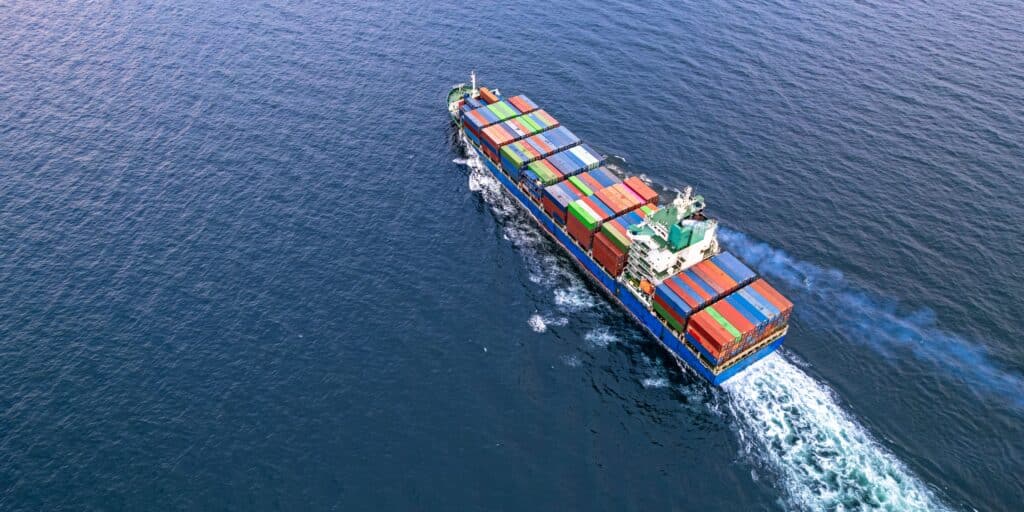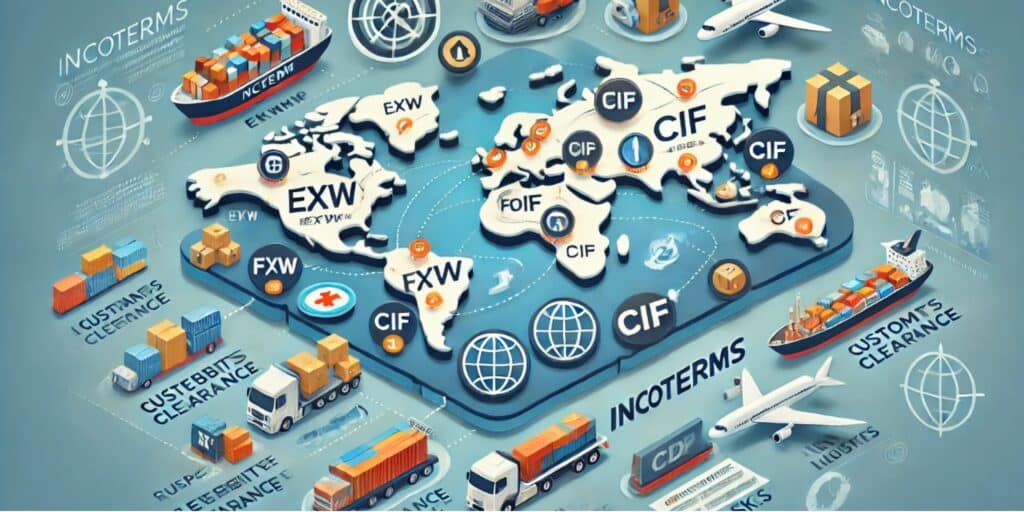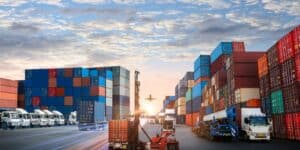International trade is like navigating a vast ocean, without a clear understanding of its rules, you risk costly detours and unexpected challenges. Whether you’re an exporter, importer, freight forwarder, or logistics provider, misunderstanding trade regulations can lead to expensive mistakes.
Incoterms (International Commercial Terms) are essential in this journey, serving as a universal framework that defines responsibilities, costs, and risks between buyers and sellers. These standardized terms streamline transactions, clarify obligations, and minimize disputes in global shipping. But how exactly do Incoterms influence international shipping, and why is their correct application crucial for businesses worldwide?
Incoterms and Their Role in International Trade
Before their creation, misunderstandings and disputes frequently arose due to differing interpretations of trade terms across countries. Since their inception, Incoterms have undergone multiple revisions to keep pace with the evolving landscape of global commerce. Updates were introduced in 1953, 1967, 1976, 1980, 1990, 2000, 2010, and most recently, Incoterms 2020. Each revision reflects changes in trade practices, transportation methods, and regulatory requirements, ensuring that businesses worldwide operate under clear and standardized rules.
Definition and Purpose
In global commerce, clear and standardized communication is essential for seamless transactions. This is where Incoterms provide a crucial framework.
What are Incoterms?
Incoterms (International Commercial Terms) are a globally recognized set of standardized trade rules that define the responsibilities of the seller and buyer in an international transaction. They outline who is responsible for the transportation, insurance, customs duties, and delivery of goods, ensuring clarity in trade agreements.
Why were Incoterms created?
Incoterms were introduced by the International Chamber of Commerce (ICC) in 1936 to eliminate confusion caused by different trade practices across countries. They provide a universal framework that helps avoid disputes and misunderstandings in cross-border transactions.
How they standardize international trade?
Revised every 10 years, Incoterms reflect evolving international trade practices. They define cost allocation, risk transfer, and logistics responsibilities, ensuring that both buyers and sellers understand their obligations. By using them, businesses can streamline global transactions, reduce risks, and enhance efficiency in shipping and insurance arrangements.
Evolution of Incoterms Over Time
Since their introduction, Incoterms have evolved to keep pace with the changing landscape of global trade. Each revision reflects advancements in transport, logistics, and regulatory requirements. The latest version, Incoterms 2020, introduced key changes, including the replacement of DAT (Delivered at Terminal) with DPU (Delivered at Place Unloaded) to clarify delivery at a final destination. It also revised FCA (Free Carrier) to allow bills of lading before cargo is loaded.
Compared to previous versions, Incoterms 2020 provide more flexibility in insurance responsibilities under CIF and CIP terms. Industries worldwide continuously adapt to these updates to streamline operations, ensuring efficient cargo handling and minimizing trade disputes. These revisions help businesses better navigate complex international transport networks and delivery obligations.
How They Define Responsibilities Between Buyers and Sellers
International Commercial Terms establish clear rules for the division of shipping duties between buyers and sellers, ensuring smooth transactions. Each contract specifies an agreed term that defines who is responsible for carriage, insurance, and customs clearance. Cost-sharing principles vary depending on the named Incoterm; for example, under EXW (Ex Works), the buyer covers all costs from the seller’s location, while under DDP (Delivered Duty Paid), the seller bears all expenses until delivery. Additionally, they determine when the transfer of ownership and risk occurs.
In FOB (Free on Board), risk shifts to the buyer once the goods are loaded onto a vessel at the port of departure. These standardized terms help prevent disputes, ensuring each party understands their financial and logistical obligations throughout the shipping process.

Impact on Shipping Logistics
Different Incoterms and Their Role in Defining Responsibilities
Today, with the growing volume of global shipments and the complexities of cross-border commerce, understanding the role of Incoterms is essential. They define the point at which risk and responsibility transfer from the seller to the buyer. Currently, there are 11 Incoterms, categorized into four groups: E, F, C, and D, based on the point of delivery and cost distribution. Each Incoterm is suited for specific transport modes and scenarios.
Group E – Departure
EXW (Ex Works): The seller makes the goods available at their premises or another named location. The buyer assumes full responsibility, including export clearance and transportation.
Group F – Main Carriage Unpaid
FCA (Free Carrier): The seller delivers goods to a shipper or a named location. The buyer assumes risk from this point.
FAS (Free Alongside Ship): Seller places goods alongside the vessel at the port; the buyer assumes risk and cost from there.
FOB (Free on Board): Seller loads goods onto the ship; responsibility shifts to the buyer once onboard.
Group C – Main Carriage Paid
CFR (Cost and Freight): Seller pays freight costs to the destination port, but risk transfers to the buyer upon loading.
CIF (Cost, Insurance, and Freight): Similar to CFR but includes insurance arranged by the seller.
CPT (Carriage Paid To): Seller covers transport to the buyer’s named place but not insurance.
CIP (Carriage and Insurance Paid To): Like CPT, but the seller also covers insurance.
Group D – Arrival
DAT (Delivered at Terminal): Seller delivers goods to a named terminal at the destination port, handling unloading.
DAP (Delivered at Place): Seller delivers goods to a named place, ready for unloading.
DDP (Delivered Duty Paid): Seller covers all costs, duties, and risks until delivery at the buyer’s destination.
Risks and Liabilities
Each Incoterm specifies who will bear the risk at different stages of the shipment. For example, under EXW, the buyer assumes full responsibility once the goods leave the seller’s premises, while in DDP, the seller must cover all risks until delivery at the import location.
Liability concerns often arise from unclear terms regarding damage, loss, or delays. Buyers may assume goods are insured when they are not, especially in CFR, where the seller pays for freight but not insurance. Common disputes stem from misunderstandings about when risk transfers, customs import duties, and the seller’s obligations under agreed Incoterms.
Case Studies: How Businesses Use Them Effectively
The following case studies highlight how a logistics provider, a manufacturer, and a retailer effectively apply Incoterms to enhance their operations.
- A Logistics Company Cutting Costs Smartly
DHL, a global logistics provider, optimized shipping costs for a European electronics distributor by switching from EXW (Ex Works) to FCA (Free Carrier). Under EXW, the distributor was responsible for all transport costs from the supplier’s factory, including export clearance.
- A Manufacturer Reducing Risks Smartly
Bosch carefully chooses shipping agreements to manage liability and ensure smooth cross-border deliveries. Through the terms that keep control over critical transport stages, the company mitigates risks related to damages and delays.
- A Retailer Enhancing Delivery
Zara, the fashion retailer, improved its global supply chain by negotiating DDP (Delivered Duty Paid) with suppliers in Asia. This meant suppliers covered customs duties and import clearance, allowing Zara to receive goods faster at its European distribution centers.
Financial and Strategic Influence
Smooth and efficient transactions rely on a shared framework that standardizes global commerce. A well-defined system helps streamline logistics, costs, and risk management. This ensures clarity in responsibilities, reducing disputes between buyers and sellers.
Influence on Shipping Costs and Pricing Strategies
Some terms, like EXW, place most costs on the buyer, while DDP requires the seller to cover all expenses, including import duties. These choices influence the total landed cost, which includes transport, insurance, and customs fees. Hidden costs, such as port handling charges or storage fees, can arise if responsibilities are unclear. Unexpected expenses may also occur due to delays or regulatory changes. Businesses must carefully evaluate terms to avoid financial surprises and optimize pricing strategies.
Impact on Trade Compliance and Customs Processes
Selecting the right terms is crucial for ensuring smooth customs clearance and compliance with regulations. Different agreements determine who is responsible for customs duties and taxes, impacting overall costs. For example, under DDP, the seller must cover import taxes, while EXW places this burden on the buyer.
Documentation requirements also vary; CIF and FOB require specific shipping and insurance documents, while DAP and DDP require detailed customs declarations. Incorrect or incomplete paperwork can lead to delays, fines, or cargo being held at the border. To avoid penalties, businesses must align their agreements with local regulations, ensuring all customs responsibilities are clearly defined.
Sinay’s Technologies for Shipping Efficiency and Compliance
Optimizing shipping operations under different Incoterms requires advanced technologies that enhance visibility, mitigate risks, and ensure compliance with customs and environmental regulations. We specialize in data collection, real-time monitoring, and environmental impact assessments to help businesses navigate these complexities. Metocean Analytics provides precise weather and ocean condition insights, minimizing disruptions and improving cost predictability.
Safecube, our container tracking platform, offers real-time shipment visibility across 180 carriers, reducing delays and unexpected expenses. Our expertise in maritime data collection supports compliance by ensuring accurate documentation and customs adherence. Additionally, Passive Acoustic Monitoring (PAM) helps companies meet environmental regulations by detecting underwater noise and marine mammals. With advanced tracking and predictive analytics, our solutions optimize logistics, reduce risks, and ensure cost-effective shipping under any Incoterm agreement.
Conclusion
Navigating the complexities of international trade requires standardized rules to ensure seamless transactions across borders. Incoterms provide this essential framework by defining responsibilities, cost distribution, and risk allocation between buyers and sellers. Their correct application streamlines global trade, minimizes disputes, and enhances supply chain efficiency. From logistics optimization to compliance with customs regulations, businesses benefit from choosing the right terms. As global trade evolves, staying updated with Incoterms ensures companies can adapt to changing practices and maintain competitive, cost-effective shipping strategies.
FAQ on incoterms
Incoterms (International Commercial Terms) are standardized trade rules that define buyer and seller responsibilities for shipping, insurance, and customs clearance.
They determine who pays for freight, insurance, and duties, affecting the total cost and risk allocation in an international trade transaction.
Popular Incoterms include FOB (Free on Board), CIF (Cost, Insurance, and Freight), EXW (Ex Works), and DDP (Delivered Duty Paid), each specifying different obligations.
They provide clarity, reduce disputes, and streamline global transactions, ensuring all parties understand their responsibilities in the shipping process.



